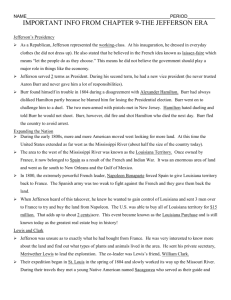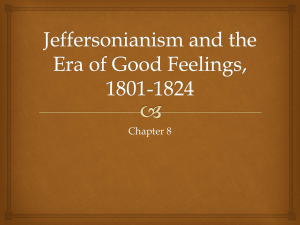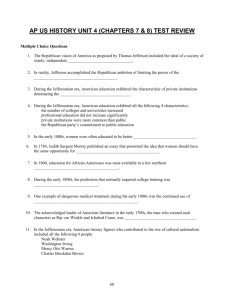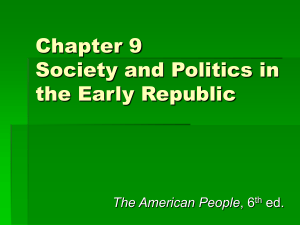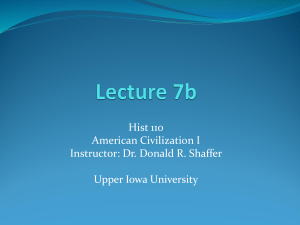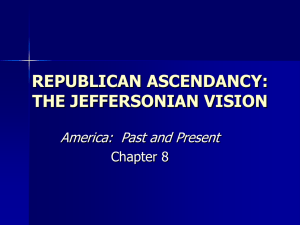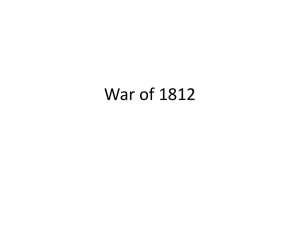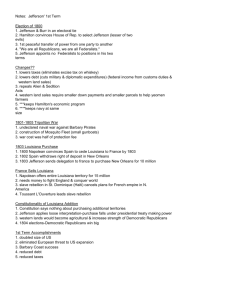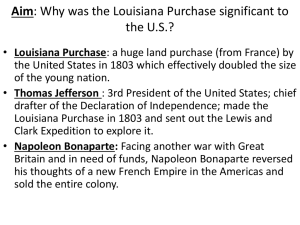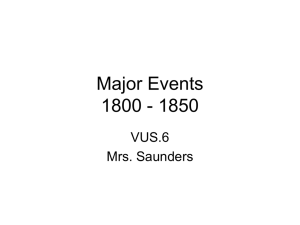Jefferson, Madison, Monroepresidency
advertisement
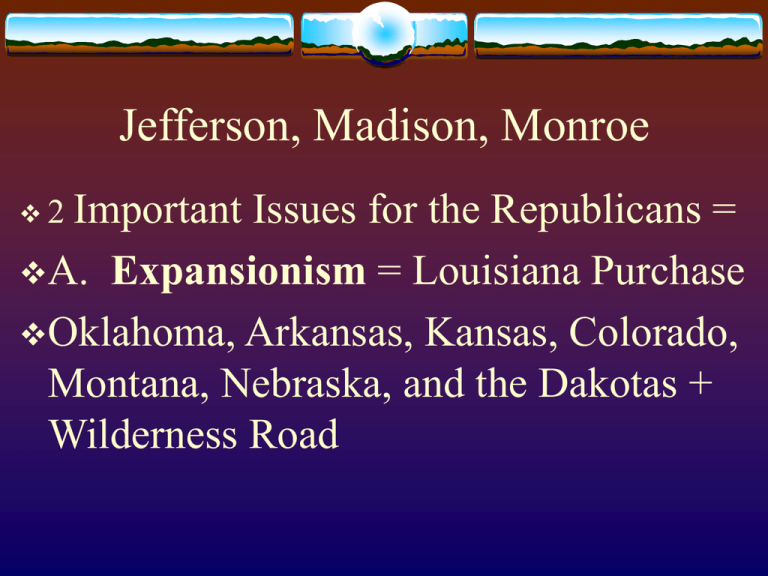
Jefferson, Madison, Monroe Important Issues for the Republicans = A. Expansionism = Louisiana Purchase Oklahoma, Arkansas, Kansas, Colorado, Montana, Nebraska, and the Dakotas + Wilderness Road 2 Nationalism B. = Era Of Good Feelings A new spirit of pride and national unity, superiority of America, loyalty rises, emphasis on education Thomas Jefferson Diplomat, Architect, Writer, Scientist, President Founder of the University of Virginia Father of the Declaration of Independence Thomas Jefferson= 3rd President Cutting Costs & Simplifying Finances Judicial Changes War on Judiciary : impeaching judges : only for criminal behavior Marbury vs. Madison strengthened the Supreme Court = Judicial Review Expansionism The West is opened The Wilderness Road: Cumberland Gap = Louisiana Territory $15 million France Needs $$$$ Louisiana Territory $15 + New Orleans million The U.S. doubled in size!! Lewis & Clark The Lewis and Clark Expedition 2 years Great Discoveries TeachersFirst Resource Listings Aaron Burr Election of 1800 Burr and Thomas Jefferson each had seventy-three votes, and the House of Representatives on the thirty-sixth ballot elected Jefferson President and Burr Vice President; Aaron Burr Got Milk????? Lost the election of 1800 by 2 votes !! Wanted to start another country, exposed by Hamilton. Burr challenges Hamilton to a duel with pistols. Alexander Hamilton Dies challenged and mortally wounded Alexander Hamilton in a duel fought at Weehawken, N.J., July 11, 1804; indicted for murder in New York and New Jersey but never tried in either jurisdiction; Escaped to South Carolina then returned to Washington and completed his term of service as Vice President; Arrested and tried for treason in August 1807 for attempting to form a republic in the Southwest of which he was to be the head, but was acquitted; Went abroad in 1808 returned to New York City in 1812 and resumed the practice of law; Died in Port Richmond Staten Island, N.Y., September 14, 1836; interment in the President’s lot, Princeton Cemetery, Princeton, N.J. Newspaper Article : Explain the Headlines 1. Presidential Style 2. National Administration 3. Judicial Changes 4. Westward Expansion The U.S. Enters the War of 1812 As Napoleon expected, war broke out , last for 12 years. 1. 2. Blockades & Impressment Force Americans to become Brit Soldiers.. 3. The Chesapeake Incident Entered American Ship – forced impressment Brits 4. War Hawks Henry Clay, John C. Calhoun wanted war. 1. Southern planters & western farmers hurt by Brits trade restrictions. 2. Native American clashes in the West blamed on English. Armed them. Embargo Act Halts all trade between US & Europe Hurts the US the most. Repealed after 2 years. The War Hawks Hate Impressment Hate Indians Tecumseh organized Creeks to not sell land Confiscated weapons from Indians were made by England Mr. Madison’s War The War of 1812 Britain and American Conflict : the Final time Tippecanoe Tecumseh, a Shawnee leader, believed that Indians needed to unite to protect their land. His brother, the “Prophet” lived in traditional Native American way of living in Indiana. William Henry Harrison Governor of Indiana is Prepared to stamp it out!! ¼ of Harrison’s troops killed or wounded. Shattered Indians belief in their Prophet’s leadership. Tecumseh fled to Canada. Prove that British were helping the Indians. The War of 1812 Mixed Results Andrew Jackson is a hero in Battle of New Orleans The Treaty of Ghent: restored boundaries. Little else. Florida The Second War for Independence Burned Washington Changes from the War of 1812 Northern boundary of Louisiana Territory No more quarrels over boundaries Britain and U.S. agreed to 10 yr. Joint occupation of Oregon Country Opened Western coast to U.S. Spain gives Florida to U.S. Star Spangled Banner Francis Scott Key wrote this anthem. National & Sectional Feelings Grow 1. The Great Foreign Disputes are settled. One party rule. 2. Rapid Economic Expansion 3. Beginning of the Machine Age : Eli Whitney Lowell – factories Women Labor Choices for Women Seth Thomas – mechanical clock Machine Age Machine Age Is Born Lowell Mills Factory System Women Workers opportunity ELi Whitney Cotton is King !! Seth Thomas Mechanical Clock National & Sectional Feelings 1. Era of Good Feelings: Nationalism 2. American System 3 Protective Tariffs Jackson invades Florida. Expands the border. Seminoles = runaways Raids against Americans, Spain cannot control. Jackson & troops enter Fla. Destroyed villages & seized The Spanish settlements. Removed the Governor. Spain gives territory to US = Adams Onis Treaty. 4. Transportation Improvements Canals Erie Canal in 1825. 5. The Second Bank of the U.S. National bank to disperse money, make loans, & control state banks. 6. Monroe Doctrine The USA is not to be “considered as subjects for future colonization by any European powers.” Prevents others from interfering in the Latin American political affairs. 7. Missouri Compromise Missouri entered the Union as a Slave State. Maine came in as a Free State. Union had 11 free & 11 slave states in 1819. Missouri Compromise preserved a balance. Henry Clay is the author & promoter. The Missouri Compromise: Henry Clay composes = The Great Compromiser It resolves conflict for 20 years!! Growing Sectionalism Henry for : Clay organized and campaigned Cheap Labor Maine is admitted as a free state. Keep a balance between the states!! Missouri is admitted as a slave state Preserves the balance in the SENATE. Louisiana Purchase is Split Territory 2 Spheres of interest 1 for Slave Holders 1 for Free Settlers North is Free South is Dependent on Slavery President Monroe signs in 1820 Stability = Era of Good Feelings New Inventions Change Lives The South Becomes a Cotton Kingdom Eli Whitney’s Invention A land rush Running a Cotton Plantation Financing a Cotton Kingdom I. Industrial Revolution Spreads A. The Use of interchangeable parts B. The growth of Mills C. Working Conditions D. The Boarding House Lots of rules Attend Church E. The First Factory Strike The Southern Economy Cash Crops: Tobacco, Cotton, Indigo, Rice Cotton Becomes King 1840’s = 2 million bales of cotton produced 1860’s = 4 million 2/3 of the U.S.’s export trade Planters 1850 Southern White population = 6 million 347,525 were slave holders But 37,000 were planters/ held 20 or more slaves 8,000 held 50 or more slaves 11 held over 500 slaves Most were Yeoman Farmers They worked on the land themselves. Slavery Plantations depended on slavery Most worked on Plantations 2 groups Field Laborers House slaves Coping with Slavery Culture Songs – Dreams of Freedom Resistance & Rebellion Religion
